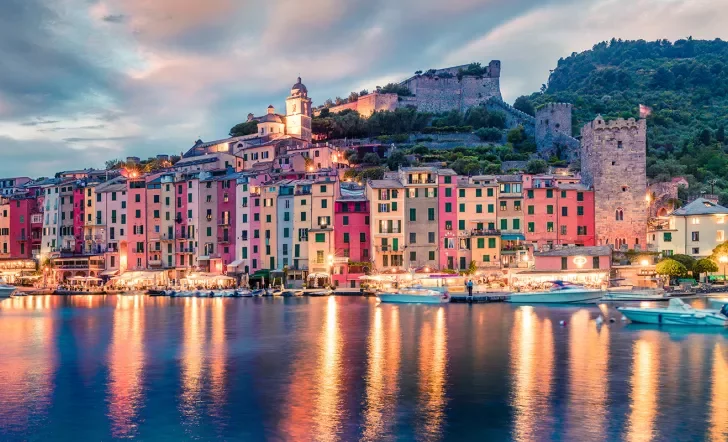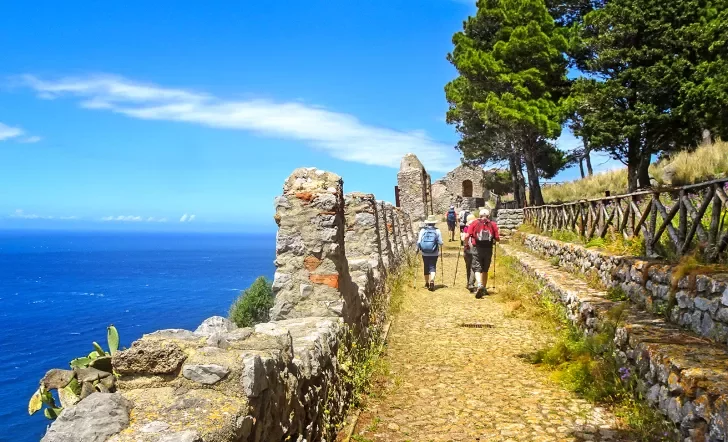With its balmy Mediterranean climate, amazing food and gorgeous, varied natural backdrops, Italy’s the envy of the rest of Europe. You can have a great vacation here any time of year. Even if a surprise thunderstorm, winter snow or blistering heat wave stops your sight-seeing plans short, you can always eat! If (somehow) you’ve had your fill of pasta, risotto and mind-blowingly fresh local produce, there’s always wine. Still, to truly make the most of your visit to Italy, it helps to be prepared. Pack for variable weather.

Weather in Italy
(All temperatures quoted are in Fahrenheit.)
Spring
You can’t rely on the weather in March, when average temperatures still hover around the 40s in northern Italy and the 50s in the south. On the other hand, April and May are dreamy. They’re cool enough for hiking and walking around but warm enough you don’t need much more than a light jacket.
Summer
June in Italy is pleasantly toasty, but July and August can get quite hot, with temperatures in the 90s and even 100s. It’s a manageable, dry heat in coastal areas (plus you’ve got the sea to cool you down), but it can be muggy and stifling inland.
Fall
In September and October, the scorching heat subsides, but there’s still abundant sun, and the Mediterranean remains as warm as a bathtub. Expect temperatures in the 60s to 80s, dipping down into the 50s by November.
Winter
Southern Italian winters are mild, with temperatures in Rome and its environs rarely dipping below 50. It’s worse in Northern Italy, where the climate resembles that of neighboring Switzerland and Austria. Expect temperatures in the 30s and 40s, as well as frequent rain and occasional snow.
Backroads Pro Tip
That 19th-century hotel room or rental apartment you’re thinking of staying in might look romantic and charming, but the majority of Italy’s older buildings lack air conditioning, which can come as a shock to some international travelers. If you’re traveling in summer and don’t want to sweat yourself to sleep every night, check about the AC situation before you book. (The same goes with proper heating in winter. You’d be surprised how many places make do with tiny electric space heaters.)
Special Events
Italy doesn’t miss out on an excuse for a celebration, and true to the stereotypes, most of the biggest revolve around Catholicism and food.
Carnavale (Late February/Early March)
Italy’s pre-Lent bacchanalia is marked by parties, rituals and parades almost everywhere, but Venice is the de facto carnival capital. Festivities kick off two weeks in advance, culminating in a magnificent fireworks display on Shrove Tuesday itself. The big masquerade balls are prohibitively expensive, but you don’t have to shell out €500 to join the fun. Nearly every street and piazza during this time is overtaken by masked revelers, street performers and gawking tourists.
Sanremo Music Festival (Late January/Early February)
This is Italy’s biggest, cheesiest and most fun music festival and competition. It’s held in the town of Sanremo, which is close to the French border, and it’s watched on TVs all over the country. Big-name guests, such as Sting and Elton John, join local acts that range from the sublime to the ridiculous. (One of last year’s fan favorites was a song about grammar!) You don’t need to buy tickets; just find a bar that’s livestreaming the festivities, and get ready to sing along.
Easter (April)
Easter is huge in this deeply Catholic country, and street fairs, parades and idiosyncratic traditions vary from town to town. Two of the biggest are Rome’s Pope-led Via Crucis procession between the Colosseum and the Forum and Florence’s spectacular “exploding of the cart,” where a carriage loaded with fireworks is paraded through town and then set off in a brilliant pyrotechnic display.
Festa della Republica (June 2)
This is Italy’s version of Independence Day, and it celebrates the country’s formation as a republic and the fall of fascism after the end of World War II. Accordingly, you’ll see a lot of tricolore flags, and most shops and attractions will be closed. In Rome, the occasion is marked with a giant military parade and air show.
Alba Truffle Fair (October–November)
The region of Alba produces some of the world’s most revered fungi, and every truffle season, chefs and foodies flock there to pay their respects. If you don’t have thousands of euros to shell out on a lump of this knobby white gold, you can still try it in anything from truffle butter to truffle popcorn, or sample it shaved over pasta at the local restaurants.
Food Festivals (April–October)
That seasonal local food everyone’s so into now? Italy knows no other kind. Every village has a fruit, vegetable, cheese variety or cured meat product it’s particularly proud of, a time of year when it’s at its best and a day when all the townsfolk come together to cook and to eat it. Aside from Alba’s truffle fest (see above), you’ll find sagras (festivals) dedicated to artichokes, chestnuts, mortadella…you name it.
Crowds
From late May through July, Italy fills up to the brim with tourists. In fact, they outnumber the locals in some places like Venice. If you come during this time, stay off the coach buses and big cruise ships. You’ll find fewer crowds in August, when the locals decamp for the mountains and beaches, but you get muggy weather and closed restaurants in return. Try Rome or Venice during winter for the most like-a-local experience possible, and visit Sicily or Sardinia in April or October to have the beaches to yourself.
Backroads Pro Tip
When the mercury rises, make like the locals, and don’t venture outside during the hottest part of the day. Instead, wake up early for sight-seeing; eat a big, wine-accompanied lunch; go back to your hotel to take a long nap or to read a book; and head back out around sunset for aperitivo (Italian happy hour) and dinner. Repeat as necessary.
Adventure
Biking
From ankle to toe, the boot of Italy is laced with well-kept bike trails. The steep, zigzagging paths through the Dolomites are best tackled in summer, when there’s little chance of surprise rain or snow up in the mountains. Meanwhile, the meandering, gently sloping trails through Tuscany are ideal for early autumn, which happens to be when Backroads offers the majority of its Tuscany bike tours.
Hiking and Walking
With ample sunscreen, light clothes and an early start, hiking Italy in summer isn’t as sweltering as it sounds—especially if you’re up in the Dolomites or near the breezy Sardinian coast. Save inland areas, such as Piedmont, for late spring and early fall, when you can wander for hours before stopping to refuel with a glass of wine and a plate of pasta.
Boating and Swimming
The Mediterranean is placid and sunny enough to kayak on year round, but it’s especially inviting from April through October. If you’re looking to swim as well, go during late summer or early fall. The sea takes a few months to warm up, but once it does, it’s heavenly.
Paragliding
With its many dramatic seaside cliffs and mountain vistas, Italy’s a great place to take that leap of faith. Monte Baldo by Lake Garda is a particularly popular (and gorgeous) spot. Summer can bring unpredictable winds, though, so September is the best bet for newbies.
Travel to Italy with Backroads
Backroads offers numerous ways to experience the very best of Italy on our award-winning active travel adventures. Explore this country in the best and most genuine way possible—away from the crowds, buses and tourist hot spots. We hope you'll join us! Check out our full list of Italy adventures here.




